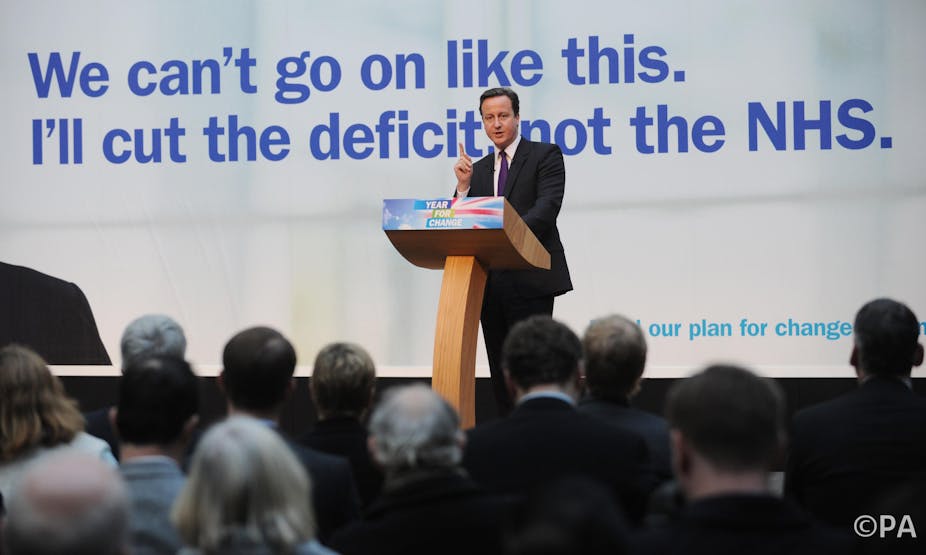It was clearly stated in the Conservative election manifesto: “We will spend at least an additional £8 billion by 2020 over and above inflation to fund and support the NHS’s own action plan for the next five years.” But close scrutiny of November’s spending review and autumn statement reveals the government has chosen its words very carefully – and that it’s not obvious how much truly “additional” money is being provided.
How much has been promised?
In fact, in January 2016, the government promised a total of £10 billion over the course of the parliament, with £1.5 billion provided in 2015-16, and £8.4 billion thereafter. In announcing the settlement, the Department of Health reported the “cumulative delivery” of the commitment. The £8.4 billion is to be front-loaded, with £3.8 billion given in 2016-17 most of which will be used to deal with hospital deficits. This will be followed by £1.5 billion in 2017-18, £0.5 billion in 2018-19, £0.9 billion in 2019-20 and £1.7 billion in 2020-21.
What’s the NHS getting?
There are two sets of carefully chosen phrases in the government’s manifesto promise. The first is “over and above inflation”. The second is “to fund and support the NHS’s own action plan”. Let’s take these in turn.
Inflation adjustments allow spending every year to be reported in “real” terms. It is usual practice to use the first year as the baseline and deflate future spending back to this starting point. It would seem safe to assume that’s been done here, particularly as it is stated in the government’s tables that 2015-16 is the baseline. But, in fact, the “additional” £8.4 billion is reported in terms of 2020-21 prices. This is not mentioned, but it matters. If we use 2015-16 prices, the “additional” commitment amounts to just £7.6 billion.
As to the second set of words, most people seem to believe that “additional” money is going to the NHS and that the Department of Health’s budget will be £7.6 billion (or £8.4 billion) higher in 2020-21 than it is now. But, actually, the government is talking about the budget for NHS England, which is the organisation that will hold the money “to fund and support the NHS’s own action plan”, the so-called Five Year Forward View.
NHS England currently controls around 85% of the Department’s budget and is the national body responsible for commissioning health services. So NHS England is to get a bigger budget. But much of the increase will come from cuts to other NHS organisations and arm’s-length bodies funded from the Department’s budget. This is simply robbing Peter to pay Paul.
Where are the cuts being made?
The £5 billion annual budget for Health Education England, used to train the current and future workforce, is to be reduced by £1.2 billion, meaning that bursaries will no longer be available to student nurses. The public health grants paid by the Department to local authorities are set to fall from £3.5 billion to just £3.1 billion in real terms over the next five years. This puts at risk plans for a radical upgrade in prevention and public health, unless local authorities somehow make up the difference.

And the Department’s capital budget will fall in real terms from £4.8 billion in 2015-16 to £4.4 billion in 2020-21. This will hinder the uptake of new technology and reduce the capital-to-labour ratio, the likelihood being that this will reduce NHS productivity.
Of course, the increase to NHS England’s budget isn’t solely to be funded from cuts elsewhere. The government is providing some truly additional funding over and above inflation. But rather than “at least an additional £8 billion by 2020”, the real terms increase compared to 2015-16 amounts to just £4.5 billion.
Lowest funding increase in NHS history
The language used by the Department continues to imply that more money is being provided to the NHS than is truly the case. The announcement of an extra £2.4 billion a year for GP services is the latest example. “Extra” means additional to existing spending on GP services – not that the Treasury is providing extra money for this initiative. Rather, once again, it is to be funded by diverting funds from elsewhere, but where the cuts will be made has not yet been specified.
To reiterate, the government’s spending commitments mean that the Department of Health’s budget will be only £4.5 billion higher in 2020-21 than in 2015-16. The annual funding increases are the lowest in NHS history and leave a substantial funding gap between what the NHS needs and what it is set to receive.

